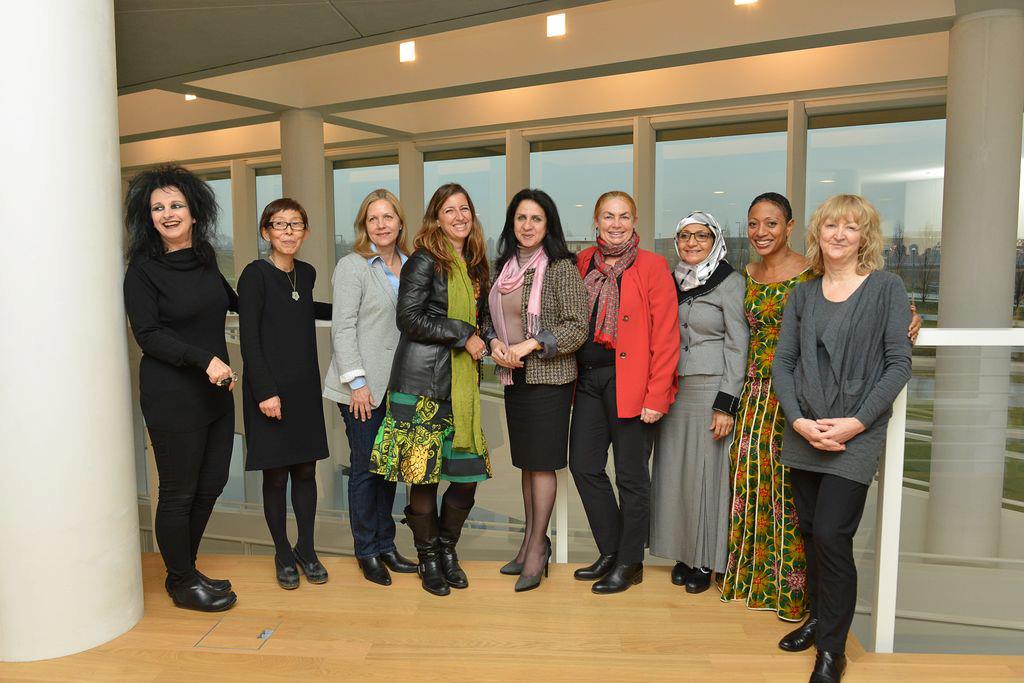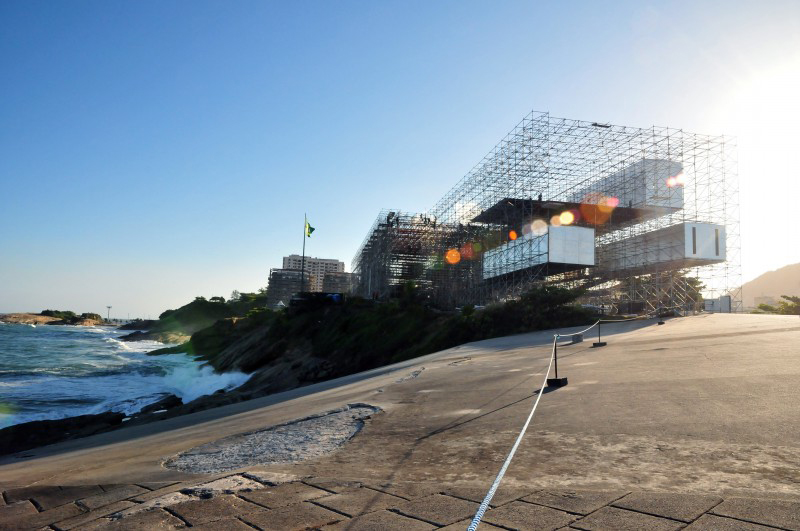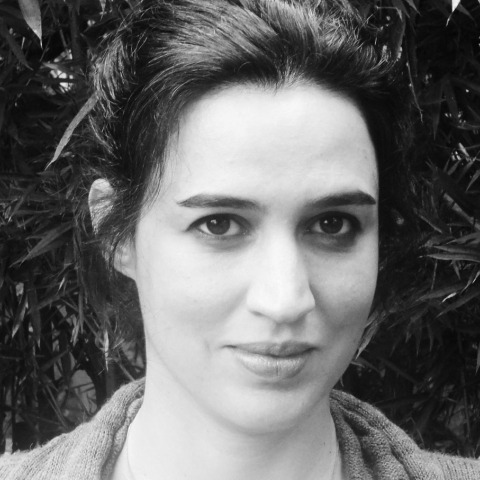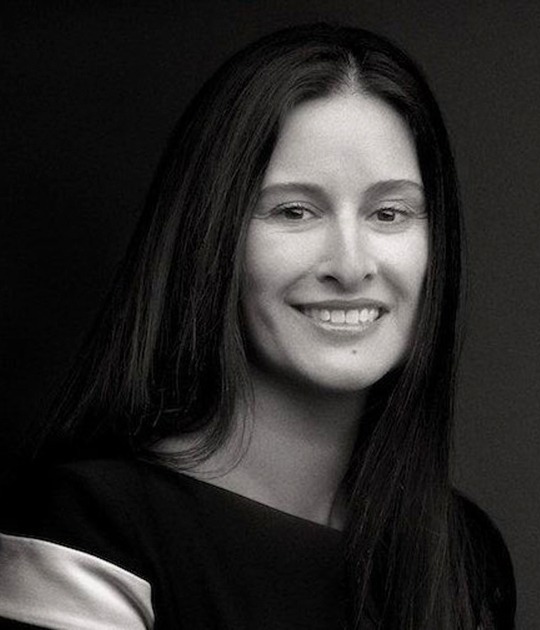The Jury decided to particularly award the Umanidade 2012 pavilion project developed for Rio +20 (the UN conference on sustainable development), designed and built together with an artist, Bia Lessa. The symbolic value of the pavilion, an impermanent structure, is heightened by the fact that Rio Mas 20 was an important opportunity for a global assessment of what is being done or not being done to save the Earth from environmental disaster.

Jury from left to right. Odile Decq, Kazuyo Sejima,Martha Thorne, Benedetta Tagliabue, Vera Baboun, Victoire de Margerie, Shaikha Al Maskari, Samia Nkrumah, Yvonne Farrell
According to the Jury composed of Shaikha Al Maskari, Vera Baboun, Odile Decq, Victoire de Margerie, Yvonne Farrell, Samia Nkrumah, Kazuyo Sejima, Benedetta Tagliabue, Martha Thorne and assisted by Stefano Casciani, the Scientific Director of the Prize, Carla Juaçaba embodies those qualities necessary in an architect of courage in approaching her profession, creativity in seeking unconventional solutions and enormous sensitivity to the context in which her works will reside.
The Jury also awarded three Special Mentions, to Izaskun Chinchilla from Spain for her non conventional approach, Anupama Kundoo from India for her skill in researching materials, and Siiri Vallner from Estonia for her sensitive interpretation of spaces.
The Prize winner was announced last friday in Bergamo at i.lab, the Italcementi research and innovation centre recently completed from a project by Richard Meier and one of the first buildings in Europe with LEED Platinum certification, the top international recognition for sustainable construction.
“With this award we want to highlight the growing importance that female designers have been assuming in architecture in recent years and pay tribute to a “positive discrimination” in favor of women,” said Italcementi CEO Carlo Pesenti. “Hopefully, in sectors traditionally governed by men, women will come to assume a central role and overcome every form of discrimination or exclusion from decision making and production. Men and business need the energy and sensitivity of women to grow and achieve ever greater results.”

Pavillion Humanidade2012
We propose a scaffold building, translucent, exposed to all weather conditions: Light, heat, rain, sounds of waves and wind, reminding man of his frailty when compared to nature.
The structure is composed of 5 structural walls measuring 170m in length and 20 meters high, with 5,40meters in between them, creating a suspended walkway over Rio’s landscape, interrupted when necessary by spaces meant for reflection and thought. The exhibitions rooms act as bracing of the whole structure, stiffening the structure as a whole.
Scaffold is the only material that we know of that can support such a weight, and through which rain and wind can pass through. One of the main goals in architecture concerning sustainability is to build with what you have in hand.
The materials we used are sustainable, meaning that everything is 100% reusable. The project composed by materials previously used, the scaffold leaves its usual place, as support structure, to become a building all by itself.
The material has been and will become other projects in the future. During my first visit to the site, Bia and I found a scaffold base that was to be used on the event that was taking place then. These bases are usually covered up by white plastic tents. So, it was then that we realized the full potential and the opportunity of using this material.
I’d like to quote the architect Paulo Mendes, who inspired us when thinking about sustainability and how it affects architecture: “For me, the cornerstone of architecture is the geography.” In other words, sustainability and geography are closely related in architecture. It might make sense to build on Africa or in some places in Brazil using clay, or to create green roofs in Buenos Aires, but not in this specific site in the fortress of Copacabana. It’s as if every specific geographical point has to find it’s own equilibrium.
Txt.- Carla Juaçaba
CREDITS
General conception and direction.-Bia Lessa
Architecture.- C
arla Juaçaba
Light Designer.- Paulo Pederneiras
Architects.-
Antonio Pedro Coutinho / Pedro Varella / Sergio García–Gasco Lominchar / Elza Burgos De La Prida/ Argus Caruso
Architecture Trainees.-
Daniel Cuchicho / Rita D’aguilar / Barbara Cutlak / Alvaro Pitas Electronic Model:
Bruno Caio / André Wissenbach
Scenography Direction.-
Abel Gomes
Execution.-
P&G Cenografia
Creative Executive Production.-
Lucas Arruda
Structure.- Mvd Osmar Dutra
Sound Designer.- Dany Roland
Graphic Design.- Fabio Arruda E Rodrigo Bleque – Cubículo
Landscape.-
Daniela Infante
Lighting.- Naldo Bueno
Produção Geral.- Srcom
Content / Curatorship.-
Fiesp / Firjan


































![10 Architecture Studios Led by Women [II] 10 Architecture Studios Led by Women [II]](/sites/default/files/styles/mopis_home_news_category_slider_desktop/public/metalocus_women-arch-2016_eng-8_0.png?h=5c593260&itok=Wb9aNuM7)





